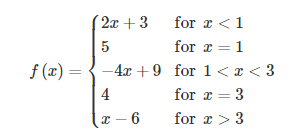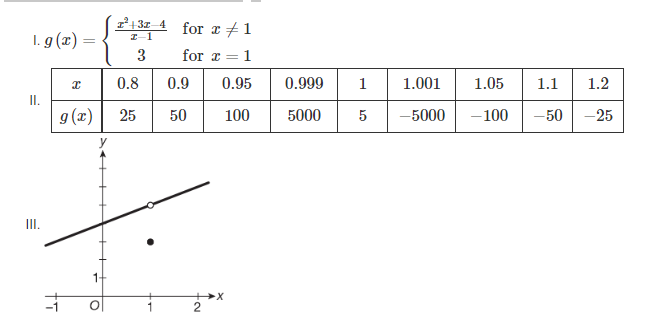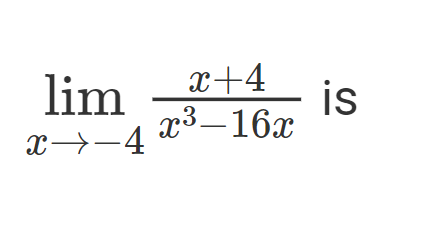Calculus Final Exam - Limits Algebraically and Continuity
1/11
There's no tags or description
Looks like no tags are added yet.
Name | Mastery | Learn | Test | Matching | Spaced |
|---|
No study sessions yet.
12 Terms
If g is the function defined by g(x) = (cos x - sin x) / (1-2sin2x) , what is lim x → pi/4 g(x)?
1/sqrt (2)
Which of the following functions is not continuous on the interval −∞<x<∞ ?
A) f(x) = 4(x)2-2x + 1
B) g(x) = 1/ (x3 + 3(x)2 - 2x - 5)
C) h(x) = cos(pi x)
D) k(x) = 1 / ex
B) g(x) = 1/ (x3 + 3(x)2 - 2x - 5)
If f is the function defined by f(x)= (x2−4) / (x2+ x−6), then lim x→2 f(x) is
4/5

Let f be the piecewise function defined above. Which of the following statements is false?
A) f is continuous at x =1
B) f is continuous at x = 2
C) f is continuous at x = 3
D) f is continuous at x = 4
C) f is continuous at x = 3
lim x→3 (x−3) / x3−9x) is
1/18

Let g be a function that is increasing for x<1 and increasing for x>1. If lim x→1 g(x)=5, which of the following could represent the function g ?
I and III only
If f is the function defined by f(x)= (x2−1) / √(x)−1, then lim x→1 f(x) is
4

Step 3

I and III only

1/32

A) f has a discontinuity due to a vertical asymptote at x = 0 and x = 1
B) f has a removable discontinuity at x = 0 and a jump discontinuity at x = 1
C) f has a removable discontinuity at x = 0 and a discontinuity due to a vertical asymptote at x = 1
D) f is continuous at x = 0, and f has a discontinuity due to a vertical asymptote at x = 1
C) f has a removable discontinuity at x = 0 and a discontinuity due to a vertical asymptote at x = 1

The graph of the function f is shown above. What are all values of x for which f has a removable discontinuity?
0 and 2 only